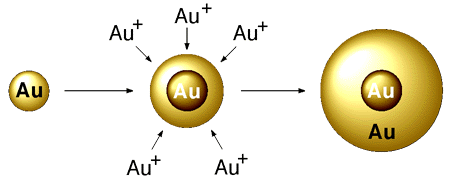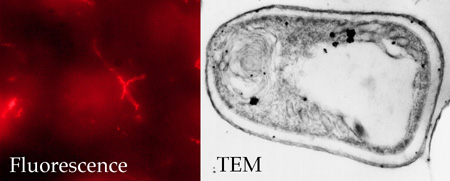
|
|
Contents: News Stories, 1999
|
November 15, 1999
NIH Awards New Phase I SBIR Grant for the Development of Novel Luminescent Lanthanide Chelate Labels for Time-resolved fluorometry
The National Institute of Diabetes and Digestive and Kidney Diseases (NIH) has awarded a Phase I Small Business Innovation Research (SBIR) Grant to Nanoprobes, Incorporated (Stony Brook, NY) of $ 100,000 for the six months beginning September 30, 1999. This grant, entitled "Luminescent Lanthanide Chelates as Non-isotopic Labels for Immunoassays," will support the development of novel macrocyclic lanthanide chelate labels that will incorporate a sensitizer as well as a reactive group for their covalent attachment to antibodies. The new methodology is expected to eliminate an enhancement step that is necessary for commercially available lanthanide labels and speedup time-resolved immunoassays. The new luminescent lanthanide labels can also be used for DNA hybridization assays, flow-cytometry and time-resolved fluorescence microscopy.
Synthesis of new macrocycles and their chelates will be conducted by Drs. Vishwas Joshi and Wenqui Liu; while their photophysical properties will be tested by Dr. Joshi and Mr. Stein. Dr. Joshi will prepare immunoconjugates and optimize immunoassays of hormones using the newly developed luminescent lanthanide labels. If you are interested in collaborating on this project (for example, if you have a novel application for which one of the new probes sounds uniquely suited) please E-mail Dr. Joshi at: vnjoshi@nanoprobes.com.
Nanoprobes, Incorporated, founded in November 1990, researches and develops the science and applications of metal nanoparticles and autometallography. The company is a leader in immunogold technology, with products which include the 1.4 nm Nanogold® and 0.8 nm undecagold cluster immunoprobes and sensitive DNA detection reagents which are used in light and electron microscopy, molecular biology and cellular studies. Previous SBIR grants have enabled the development of the unique FluoroNanogold line of combined fluorescent and gold cluster immunoprobes, and support several ongoing research projects to develop the biomedical applications of metal cluster complexes and nanoparticles. The Company is a tenant of the Long Island High Technology Incubator at Stony Brook, New York.
For more information, contact:
Vishwas N. Joshi, Ph. D.
Scientist
Nanoprobes, Incorporated
25 East Loop Road, Suite 113
Stony Brook, NY 11790-3350
Telephone: (516) 444-8815
Fax: (516) 444-8816
E-mail vnjoshi@nanoprobes.com or nano@nanoprobes.com
WWW: www.nanoprobes.com
contents
September 23, 1999
NIH awards Second "Fast-Track" SBIR grant to Nanoprobes
The National Institute of General Medical Sciences (National Institutes of Health) has awarded Phase I of a second "Fast-Track" SBIR grant to Nanoprobes, Incorporated (Stony Brook, NY) of $ 100,000 for six months to develop large covalently linkable gold particles as alternatives to colloidal gold probes for use in microscopy and immunoassays.
Gold nanoparticles 5 to 40 nm size range will be prepared in a stable, water-soluble form using novel organic ligands to chemically control their surface properties and cross-linking reactivity. This will enable covalent cross-linking to proteins, antibodies, oligonucleotides, lipids and other targeted biomolecules. It is anticpated that new types of labels wil be developed without the drawbacks of colloidal gold, such as non-specific affinities (which can give false positive results) and probe dissociation (which can cause reduced sensitivities). Methods are planned for selective preparation and high-resolution separation of different sized particles. Preliminary results indicate that the new probes perform as well as equivalent colloidal gold probes in immunoelectron microscopy experiments, and show increased sensitivity and lower background in blots. The covalent mode of attachment will greatly expand the range of biomolecules to which these labels may be conjugated, and is expected to enable the development of new formats for rapid medical and molecular diagnostics.
The research will be performed by Dr. Richard D. Powell with Dr. Edmund Gutierrez, Dr. Frederic R. Furuya and Dr. Wenqiu Liu. Dr. James F. Hainfeld will provide advice and technical direction to the project, and new probes wil be evaluated by Dr. David L. Spector of Cold Spring Harbor Laboratory (Cold Spring Harbor, NY) and Dr. Peter M. Takvorian of Rutgers University. The grant also includes a subcontract to the State University of New York at Stony Brook, NY.
Nanoprobes, Inc., founded in November 1990, researches and develops the biomedical and high-technology applications of metal nanoparticles and autometallography. The company is a leader in immunogold technology, with products which include the 1.4 nm Nanogold® cluster immunoprobes and sensitive DNA detection reagents which are used in light and electron microscopy, molecular biology and cellular studies.
For more information, contact:
Richard D. Powell, Ph. D.
Research Director
Nanoprobes, Incorporated
25 East Loop Road, Suite 113
Stony Brook, NY 11790-3350
Telephone: (516) 444-8815
Fax: (516) 444-8816
E-mail rpowell@nanoprobes.com or nano@nanoprobes.com
WWW: www.nanoprobes.com
contents
September 15, 1999

Gold Enhancement
Nanoprobes, Incorporated announces the introduction of a unique new product, "GOLDENHANCE." This new chemical amplification reagent brings new features which are not available with conventional silver enhancement to light and electron microscopy and to membrane blotting applications.
GOLDENHANCE is a novel autometallographic enhancement reagent which, instead of silver, deposits gold catalytically onto Nanogold® and colloidal gold labels. The resulting enlarged particles are easier to detect (both by backscatter detection in SEM and higher contrast in TEM), and the reagent has many new features compared with silver enhancers. It is compatible with more buffers, including physiological buffers, unlike silver which is precipitated by halides, and is less sensitive to pH than silver enhancers. It is easier to use because autonucleation occurs later, and it is non-viscous for easy and accurate dispensing and mixing. In some systems backgrounds are cleaner and sensitivities improved, with improved optical visualization. It is expected that this reagent will extend the reach of the biomedical researcher, and is especially suitable for applications in fields such as rapid medical diagnostics and cancer detection and screening. It is available in two formulations, one optimized for electron microscopy (Catalog number 2112) and the other for light microscopy and membrane blotting (2113). For more information, see www.nanoprobes.com.
Nanoprobes, Incorporated, founded in November 1990, researches and develops the biomedical and high-technology applications of metal nanoparticles and autometallography. The company is a leader in immunogold technology, with products which include the 1.4 nm Nanogold® and 0.8 nm undecagold cluster immunoprobes and sensitive DNA detection reagents which are used in light and electron microscopy, molecular biology and cellular studies. The Company is currently a tenant of the Long Island High Technology Incubator at Stony Brook, New York.
Abstract presented at Microscopy and Micoanalysis '99
For more information, contact:
James F. Hainfeld, Ph. D.
President
Nanoprobes, Incorporated
25 East Loop Road, Suite 113
Stony Brook, NY 11790-3350
Telephone: (516) 444-8815
Fax: (516) 444-8816
E-mail nano@nanoprobes.com.
WWW: www.nanoprobes.com
contents
September 15, 1999

Cy3-Nanogold® Probe
Nanoprobes, Inc. announces a combined Cy3® and Nanogold® probe, "Cy3®-FluoroNanogold." This dual immunoprobe, that contains the fluorescent dye Cy3® and a gold particle (Nanogold®) both covalently attached to a Fab' antibody fragment, permits correlative microscopy both at the light and electron microscope level. Samples can be studied by fluorescence, or prescreened and selected for EM preparation. Since only one probe is used, there is no ambiguity about correlating the results. Cy3® fluorescence is red, and may be observed using rhodamine filter sets. It is brighter, more resistant to bleaching, and more water-soluble than that of fluorescein. Cy3® and Nanogold® are covalently attached for stability and long shelf life, and Fab' fragments and the small 1.4 nm Nanogold® are used to maintain a small overall probe size, for superior cell and tissue penetration. These properties enable superior performance in many applications, including in situ hybridization detection, where single copy viral DNA in cells has been detected by both fluorescence, bright field light and electron microscopy (using silver or gold enhancement). Currently available as goat anti-mouse (Product number 7102), goat anti-rabbit (7104), and streptavidin (7116) conjugates (Other antibodies available by special order). For more information, see www.nanoprobes.com.
Nanoprobes, Inc., founded in November 1990, researches and develops the biomedical and high-technology applications of metal nanoparticles and autometallography. The company is a leader in immunogold technology, with products which include the 1.4 nm Nanogold® cluster immunoprobes and sensitive DNA detection reagents which are used in light and electron microscopy, molecular biology and cellular studies.
Cy3® and Cy Dye® are trademarks of Amersham International PLC.
Abstract presented at Microscopy and Micoanalysis '99
For more information, contact:
James F. Hainfeld, Ph. D.
President
Nanoprobes, Incorporated
25 East Loop Road, Suite 113
Stony Brook, NY 11790-3350
Telephone: (516) 444-8815
Fax: (516) 444-8816
E-mail nano@nanoprobes.com.
WWW: www.nanoprobes.com
contents
January 29, 1999
NSF Awards New New Phase I SBIR Grant on Chemical Methods for Nanowire Preparation and Copper Interconnect Fabrication
The National Science Foundation has awarded a Phase I Small Business Innovation Research grant to Nanoprobes, Incorporated (Stony Brook, NY) of $ 99,975 for six months to support initial feasibility studies on a chemical method for fabricating copper interconnects and conductive lines for integrated circuits. The new method will use the charge patterning of gold cluster molecules by electron beam lithography, followed by chemical formation of nanowires. The new approach will provide for higher resolution and hence higher packing density in integrated circuit manufacturing: theoretical calculations indicate that it may be used to prepare conductive lines as narrow as 30 nm in diameter. In addition, it is believed that this approach may result in a simplified manufacturing process. The research will be performed by Dr. Richard D. Powell with Dr. Edmund Gutierrez, Dr. Frederic R. Furuya and Dr. James F. Hainfeld, in collaboration with Profs. Alexander H. King (Materials Science), Jahangir Rastegar (Mechanical Engineering), and James E. Lukens (Physics) of the State University of New York at Stony Brook. In addition, a portion of this grant will be matched by a Strategic Partnership for Industrial Resurgence (SPIR) grant of $ 12, 790.
Nanoprobes, Incorporated, founded in November 1990, researches and develops the science and applications of metal nanoparticles and autometallography. The company is a leader in immunogold technology, with products which include the 1.4 nm Nanogold® and 0.8 nm undecagold cluster immunoprobes and sensitive DNA detection reagents which are used in light and electron microscopy, molecular biology and cellular studies. Previous SBIR grants have enabled the development of the unique FluoroNanogold line of combined fluorescent and gold cluster immunoprobes, and support several ongoing research projects to develop the biomedical applications of metal cluster complexes and nanoparticles. The Company is a tenant of the Long Island High Technology Incubator at Stony Brook, New York.
For more information, contact:
Richard D. Powell, Ph. D.
Research Director
Nanoprobes, Incorporated
25 East Loop Road, Suite 113
Stony Brook, NY 11790-3350
Telephone: (516) 444-8815
Fax: (516) 444-8816
E-mail rpowell@nanoprobes.com or nano@nanoprobes.com.
WWW: www.nanoprobes.com
contents
|